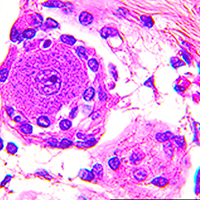Comparison of CGRP distributions in the maxillary sinus and trigeminal ganglion between elderly dentulous and edentulous humans

Submitted: 19 February 2021
Accepted: 24 March 2021
Published: 31 March 2021
Accepted: 24 March 2021
Abstract Views: 979
PDF: 471
HTML: 13
HTML: 13
Publisher's note
All claims expressed in this article are solely those of the authors and do not necessarily represent those of their affiliated organizations, or those of the publisher, the editors and the reviewers. Any product that may be evaluated in this article or claim that may be made by its manufacturer is not guaranteed or endorsed by the publisher.
All claims expressed in this article are solely those of the authors and do not necessarily represent those of their affiliated organizations, or those of the publisher, the editors and the reviewers. Any product that may be evaluated in this article or claim that may be made by its manufacturer is not guaranteed or endorsed by the publisher.
Similar Articles
- Y. Zhang, Y.J. Tang, Z.H. Li, F. Pan, K. Huang, G.H. Xu, KiSS1 inhibits growth and invasion of osteosarcoma cells through inhibition of the MAPK pathway , European Journal of Histochemistry: Vol. 57 No. 4 (2013)
- Z. Protrka, S. Arsenijevic, A. Dimitrijevic, S. Mitrovic, V. Stankovic, M. Milosavljevic, T. Kastratovic, J. Djuric, Co-overexpression of bcl-2 and c-myc in uterine cervix carcinomas and premalignant lesions , European Journal of Histochemistry: Vol. 55 No. 1 (2011)
- Yongwei Lin, Zhipeng Zhou, Lang Xie, Yongsheng Huang, Zhenghua Qiu, Lili Ye, Chunhui Cui, Effects of miR-939 and miR-376A on ulcerative colitis using a decoy strategy to inhibit NF-κB and NFAT expression , European Journal of Histochemistry: Vol. 66 No. 1 (2022)
- S. Soddu, E. Di Felice, S. Cabras, M.E. Castellanos, L. Atzori, G. Faa, L. Pilloni, IMP-3 expression in keratoacanthomas and squamous cell carcinomas of the skin: an immunohistochemical study , European Journal of Histochemistry: Vol. 57 No. 1 (2013)
- L. Pilloni, P. Bianco, E. DiFelice, S. Cabras, M.E. Castellanos, L. Atzori, C. Ferreli, P. Mulas, S. Nemolato, G. Faa, The usefulness of c-Kit in the immunohistochemical assessment of melanocytic lesions , European Journal of Histochemistry: Vol. 55 No. 2 (2011)
- E. Carabajal, N. Massari, M. Croci, D. J. Martinel Lamas, J. P. Prestifilippo, R. M. Bergoc, E. S. Rivera, V. A. Medina, Radioprotective potential of histamine on rat small intestine and uterus , European Journal of Histochemistry: Vol. 56 No. 4 (2012)
- T. Karaca, Y. Hulya Uz, R. Karabacak, I. Karaboga, S. Demirtas, A. Cagatay Cicek, Effects of hyperthyroidism on expression of vascular endothelial growth factor (VEGF) and apoptosis in fetal adrenal glands , European Journal of Histochemistry: Vol. 59 No. 4 (2015)
- Y.F. Costa, K.C. Tjioe, S. Nonogaki, F.A. Soares, J.R. Pereira Lauris, D. Tostes Oliveira, Are podoplanin and ezrin involved in the invasion process of the ameloblastomas? , European Journal of Histochemistry: Vol. 59 No. 1 (2015)
- Jiapei Lv, Wang Yanting, Shan Wei, Regulatory roles of ACSL5 in the anti-tumor function of palmitic acid (C16:0) via the ERK signaling pathway , European Journal of Histochemistry: Vol. 67 No. 4 (2023)
- Yuka Maruyama-Koide, Sumiko Mikawa, Takeshi Sasaki, Kohji Sato, Bone morphogenetic protein-4 and bone morphogenetic protein receptors expressions in the adult rat eye , European Journal of Histochemistry: Vol. 61 No. 3 (2017)
<< < 14 15 16 17 18 19 20 21 22 23 > >>
You may also start an advanced similarity search for this article.

 https://doi.org/10.4081/ejh.2021.3234
https://doi.org/10.4081/ejh.2021.3234










